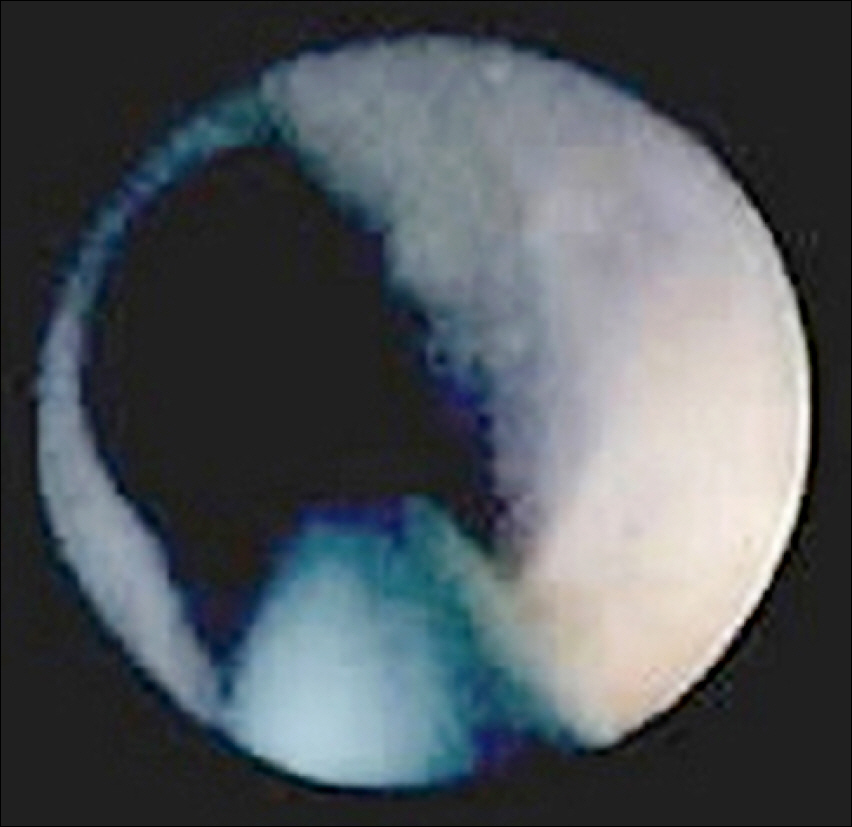Korean J Urogenit Tract Infect Inflamm.
2014 Oct;9(2):122-125. 10.14777/kjutii.2014.9.2.122.
Recurrent Urinary Tract Infection from Urethral Stricture and Urethral Hair Growing after Hypospadias Repair Surgery
- Affiliations
-
- 1Department of Urology, National Police Hospital, Seoul, Korea. msk0701@hanmail.net
- KMID: 1732627
- DOI: http://doi.org/10.14777/kjutii.2014.9.2.122
Abstract
- Despite successful hypospadias repair surgery, complications may occur. We report on a case of recurrent urinary tract infection from urethral stricture and urethral hair growth after hypospadias repair surgery. A 33-year-old man who first underwent hypospadias repair surgery at the age of seven underwent two more visual internal urethrotomy operations afterward. He was referred to our hospital because of voiding difficulty, dysuria, and residual urine sense. His urethral meatus was located at 1 cm proximal ventral sulcus from the glans. We found the urethral stricture and one hair in the urethra at the 2 cm proximal portion from the urethral meatus by retrograde urethrography and urethroscopy. Bacteriuria was found on urine culture, thus, we resolved the problems with soundation, epilation, and antibiotic therapy. However, the patient kept experiencing these problems recurrently; therefore, we managed his problems by recurrent urethral soundation, hair epilation, and antibiotic treatment with three years of regular follow-up.
MeSH Terms
Figure
Reference
-
1. Klip H, Verloop J, van Gool JD, Koster ME, Burger CW, van Leeuwen FE. OMEGA Project Group. Hypospadias in sons of women exposed to diethylstilbestrol in utero: a cohort study. Lancet. 2002; 359:1102–7.
Article2. Kim MK, Kim YG. Hypospadias repair: recent concept and development in surgical techniques. Korean J Urol. 2008; 49:1059–66.
Article3. Cook A, Khoury AE, Neville C, Bagli DJ, Farhat WA, Pippi Salle JL. A multicenter evaluation of technical preferences for primary hypospadias repair. J Urol. 2005; 174:2354–7.
Article4. Nuininga JE, DE Gier RP, Verschuren R, Feitz WF. Longterm outcome of different types of 1-stage hypospadias repair. J Urol. 2005; 174:1544–8.
Article5. Park KJ, Choi H. Assessment of longterm hypospadias repair results. Korean J Pediatr Urol. 2010; 2:81–6.6. Jones EA, Freedman AL, Ehrlich RM. Complications of hypospadias repair. Taneja SS, Smith RB, Ehrlich RM, editors. Complications of urologic surgery. 3rd ed.Philadelphia: Saunders;2001. p. 592–601.7. Devine CJ Jr, Franz JP, Horton CE. Evaluation and treatment of patients with failed hypospadias repair. J Urol. 1978; 119:223–6.
Article8. Cohen S, Livne PM, Ad-El D, Lapidoth M. CO2 laser desiccation of urethral hair post-penoscrotal hypospadias repair. J Cosmet Laser Ther. 2007; 9:241–3.9. Beiko D, Pierre SA, Leonard MP. Urethroscopic holmium: YAG laser epilation of urethral diverticular hair follicles following hypospadias repair. J Pediatr Urol. 2011; 7:231–2.10. Crain DS, Miller OF, Smith L, Roberts JL, Ross EV. Transcutaneous laser hair ablation for management of intraurethral hair after hypospadias repair: initial experience. J Urol. 2003; 170:1948–9.
Article
- Full Text Links
- Actions
-
Cited
- CITED
-
- Close
- Share
- Similar articles
-
- An Unexpected Course after Simultaneous Urethral Repair and Reimplantation of Penile Prosthesis in a Patient with a Urethral Stricture
- Bladder Mucosal Graft for Severe Hypospadias Repair
- Management of Urethral Fistulas and Strictures after Hypospadias Repair
- A Clinical Observation on 46 Cases of Hypospadias
- Patch Graft Urethroplasty for Anterior Urethral Strictufe






